Alaska global leader in commercial fisheries: study
Thursday, February 24, 2011, 00:40 (GMT + 9)
A new study by Alaska-based Northern Economics shows that the states seafood industry is not only a national but also a global juggernaut in sustainable commercial fisheries. The seafood industrys local and statewide impact is huge: the fisheries in Alaskan and federal waters off the states coast provide work to more than 80,800 people and yield more than USD 3.3 billion in wholesale value every year.
Alaska fisheries. (Photo:PSPA)
The Marine Conservation Alliance- (MCA) funded study — Seafood Industry in Alaskas Economy — constitutes an update of the 2009 report by the same name and is available online on the MCA website.
The seafood industry operates in dozens of communities along Alaskas entire coastline, remarked MCA President Frank Kelty. We create family-wage jobs where no other opportunities exist, and we bring significant new money into the state.
This years executive summary update informed that Alaska ranked first of all 50 states in both volume and value of commercial fisheries landings in 2009 with 1.84 tonnes worth USD 1.3 billion. The nationwide harvest volume was 3.6 million tonnes, informed the National Marine Fisheries Service (NMFS).
Real Wholesale Value by Species, 2003-2009. (Source: Hiatt, 2007 and Hiatt, 2010b -marineconservationalliance)

Alaskas seafood industry contributed USD 4.6 billion to its economic output in 2009.
Other points made in the study regarding the importance of Alaska to the global seafood market include:
* If Alaska were a country of its own, it would have come 14th among seafood producing countries in 2008, according to NMFS and the Food and Agriculture Organisation (FAO).
* The states landings of global groundfish species groups — such as cod, pollock, hake and haddock and flatfish made up 18 per cent of the global harvest of these species in 2008.
* That same year, some 35 per cent of the worlds capture production of species in the salmon, trout and smelt group happened in Alaskas waters.
* Alaska was responsible for 95 per cent of the USs Pacific salmon landings in 2009.
* In 2009, Alaska exported USD 1.6 billion worth of seafood directly to Japan, China, South Korea, Canada and the European Union (EU), among other destinations.
* That same year, Alaskan fish and fisheries products were exported mainly to Japan followed by China, South Korea, Germany, the Netherlands and Canada, according to the National Oceanic and Atmospheric Administration (NOAA).
Sport Fishing Forums – Offshore Big Game Fishing News Click Here
——-
Alaska global leader in commercial fisheries: study
Thursday, February 24, 2011, 00:40 (GMT + 9)
A new study by Alaska-based Northern Economics shows that the states seafood sector is not only a national but also a international juggernaut in sustainable commercial fisheries. The seafood industrys nearby and statewide influence is large: the fisheries in Alaskan and federal waters off the states coast present operate to far more than 80,800 individuals and yield much more than USD 3.three billion in wholesale value every single year.
Alaska fisheries. (Photo:PSPA)
The Marine Conservation Alliance- (MCA) funded study — Seafood Sector in Alaskas Economy — constitutes an update of the 2009 report by the same name and is available on the web on the MCA site.
The seafood industry operates in dozens of communities along Alaskas total coastline, remarked MCA President Frank Kelty. We produce loved ones-wage jobs where no other opportunities exist, and we bring significant new cash into the state.
This years executive summary update informed that Alaska ranked 1st of all 50 states in both volume and value of commercial fisheries landings in 2009 with 1.84 tonnes worth USD 1.three billion. The nationwide harvest volume was 3.6 million tonnes, informed the National Marine Fisheries Service (NMFS).
Genuine Wholesale Worth by Species, 2003-2009. (Supply: Hiatt, 2007 and Hiatt, 2010b -marineconservationalliance)
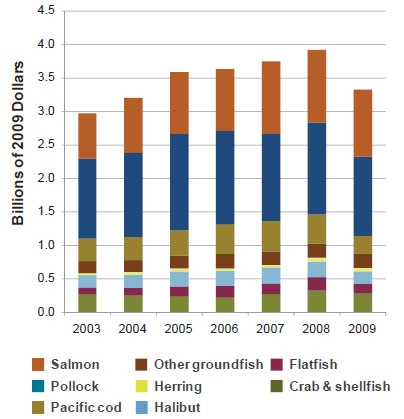
Alaskas seafood industry contributed USD four.6 billion to its financial output in 2009.
Other points produced in the study concerning the value of Alaska to the international seafood market place include:
* If Alaska had been a country of its personal, it would have come 14th amongst seafood creating countries in 2008, according to NMFS and the Food and Agriculture Organisation (FAO).
* The states landings of international groundfish species groups — such as cod, pollock, hake and haddock and flatfish produced up 18 per cent of the global harvest of these species in 2008.
* That identical year, some 35 per cent of the worlds capture production of species in the salmon, trout and smelt group happened in Alaskas waters.
* Alaska was responsible for 95 per cent of the USs Pacific salmon landings in 2009.
* In 2009, Alaska exported USD 1.6 billion worth of seafood directly to Japan, China, South Korea, Canada and the European Union (EU), amongst other destinations.
* That exact same year, Alaskan fish and fisheries goods were exported mostly to Japan followed by China, South Korea, Germany, the Netherlands and Canada, according to the National Oceanic and Atmospheric Administration (NOAA).
Sport Fishing Forums – Offshore Huge Game Fishing News Click Right here
——-
I don’t know, maybe it’s me.
Where are the Recreational Anglers in all of this?
This is what scares me, the recs are a mystery in catch shares. Generating all these databases of fisherman feels like the big screw is coming. I’ve heard it stated ahead of. Effectively we know what the commercial guys take or we have an idea, but do we truly know a lot about the recs. How several of them are you.
If you don’t consider these registry’s can be used as a sword against us, your gonna be sadly mistaken. My worry is it will be VOODOO all more than again. Just like MRFSS they will call little batches if any multiply by some element and say wholly cow you guys are catching anything that swims.
NMFS is corrupt, they have an agenda to remove as significantly participation as they can. Billion dollar family oriented industry will be produced a non element.
Appear at what this industry will face this year.
Fuel Price tag estimated at the dock to be $ five.00 by summer season
Over regulations on several species.
Shortened seasons.
Possibly filled Quotas (bluefin)
New regs achievable (Makos, Yellowfin, stripers, grouper, snapper closures)
enormous poaching and wasteful commercial fishing practices (Stripers)
The list can go on and on
I don’t know maybe its me. but I just feel a screw coming.
A increasing tide
Scientists locate proof that privatising fishing stocks can avert a disaster
Fishing and conservation
Sep 18th 2008 | from the print edition
FOR 3 years, from an office overlooking the Atlantic in Nova Scotia, Boris Worm, a marine scientist, studied what could stop a fishery from collapsing. By 2006 Dr Worm and his team had worked out that though biodiversity may possibly slow down an erosion of fish stocks, it could not avert it. Their gloomy prediction was that by 2048 all the worlds commercial fisheries would have collapsed.
Now two economists and a marine biologist have looked at an concept that may possibly avoid such a catastrophe. This is the privatisation of commercial fisheries via what are acknowledged as catch shares or Person Transferable Quotas (ITQs).
Christopher Costello and Steven Gaines (the biologist) of the University of California and John Lynham of the University of Hawaii assembled a database of the worlds commercial fisheries, their catches and no matter whether or not they have been managed with ITQs. As these fisheries had been not chosen at random and without having acquiring any experimental control, they borrowed strategies from medical literatureknown as propensity-score matching and fixed-effects estimationto help their analysis. The very first technique compared fisheries that are comparable in all respects other than the use of ITQs the second averaged the influence of ITQs more than several fisheries and examined what happened following the quotas have been introduced. Whichever way they analysed the information, they identified that ITQs halted the collapse of fisheries (and according to a single analysis even reversed the trend). The general locating was that fisheries that were managed with ITQs have been half as likely to collapse as these that were not.
For years economists and green groups such as Environmental Defense, in Washington, DC, have argued in favour of ITQs. Till now, person fisheries have offered only anecdotal evidence of the systems worth. But by lumping all of them collectively the new study, published this week in Science, is a effective demonstration that it genuinely operates. It also assists to undermine the argument that ITQ fisheries do better only simply because they are much more valuable in terms of their fish stocks to start with, says Dr Worm. The new data show that prior to their conversion, fisheries with ITQs had been on exactly the exact same path to oblivion as those with no.
Racing to fish
Encouraging as the final results are, ITQ fisheries are in the minority. Most fisheries have an annual quota of what can be caught and other restrictions, such as the length of the season or the type of nets. But this can result in a race to fish the quota. Fishermen have an incentive to perform tougher and travel farther, which can lead to overfishing: a classic tragedy of the commons.
The use of ITQs alterations this by dividing the quota up and giving shares to fishermen as a extended-term proper. Fishermen as a result have an interest in very good management and conservation since each enhance the worth of their fishery and of their share in it. And simply because shares can be traded, fishermen who want to catch more can purchase further rights rather than resorting to brutal fishing tactics.
The Alaskan halibut and king crab fisheries illustrate how ITQs can change behaviour. Fishing in these waters had turned into a race so intense that the season had shrunk to just two to 3 frantic days. Overfishing was common. And when the catch was landed, costs plummeted since the market was flooded. Significant injury and death became so frequent in the king crab fishery that it turned into one of Americas most harmful professions (and spawned its personal television series, The Deadliest Catch).
Soon after a decade of utilizing ITQs in the halibut fishery, the average fishing season now lasts for eight months. The range of search-and-rescue missions that are launched is down by much more than 70% and deaths by 15%. And fish can be sold at the most lucrative time of yearand fresh, so that they fetch a greater price.
In a report on this fishery, Dan Flavey, a fisherman himself, says some of his colleagues have even pushed for the quota to be decreased by 40%. Most fishermen will now help cuts in quota due to the fact they feel guaranteed that in the future, when the stocks recover, they would be the ones to advantage, he says.
Though governing authorities are crucial in setting up ITQs, so is policing of the system by the fishermen themselves. In the Atlantic lobster fishery a property-based program has arisen spontaneously, says Dr Worm. Households claim ownership over parcels of sea and keep other folks out. Anyone attempting to muscle in on the action risks being threatened their gear may be cut loose or their boat could vanish.
Jeremy Prince, a fisheries scientist at Murdoch University in Australia, has been involved in ITQs given that they had been pioneered in the early 1980s by Australia, New Zealand and Iceland. In Australia they are only one particular way of managing with property rights, he says. Depending on the nature of a fishery, other techniques may possibly operate far better. These may well divide up and sell lobster pots, numbers of fish, numbers of boats, bits of the ocean or even individual reefs. The best option will rely on the worth and underlying biology of every fishery, and in some places they may not perform at all. In a fishery with a big, unproductive stock that grows gradually, fishermen might choose brief-term profit to the promise of low extended-term revenue and catch all the fish straight away. Nevertheless, Dr Prince believes that, general, market place-based mechanisms are the way forward.
The most hard place to introduce market place-based conservation techniques is in international waters. Attempts to do so have ended in failure. One dilemma is that there is basically too a lot cheating in the open ocean. Some scientists consider a renegotiation of the law of the sea by means of the United Nations is the only way forwardor a total ban on fishing in international waters. Even though a dramatic course of action, the effects may not be so huge. Dr Worm reckons that 90% of the worlds fish are caught in national waters.
So, if Dr Costello and his colleagues are right and the profit motive can drive the sustainability of fisheries, why do the worlds ten,000-plus fisheries include only 121 ITQs? Allocating catch shares is a tough and frequently fraught process. In America it can take from 5 to 15 years, says Joe Sullivan, a partner in Mundt MacGregor, a law firm based in Seattle. The public, he says, occasionally resists the privatisation of a public resource and if government gets too involved in the particulars of the privatisation (rather than leaving it to the fishermen to work out), it can end up politically messy. But evidence that ITQs function is a potent new hook to capture the political will and public focus required to spread an concept that could avert an ecological disaster.
Sport Fishing Forums – Offshore Large Game Fishing News Click Right here
——-
CATCH SHARES
Unfortunately, in fisheries where there is a huge and expanding recreational sector, exclusive fishing rights proposals maximize advantages to the commercial fishing market whilst ignoring the participation and useful economic impacts of recreational fishing.
"Catch shares are naturally a key focus for this Administration and we are concerned not only about the influence they have on recreational fisheries, but also at the pace with which they are being pushed into the management technique. Catch shares are on a rapidly track and we dont really feel we have the luxury to just say no weve in no way chosen that option in any fisheries management crisis. We didnt do that during the debate more than marine protected places or open-loop LNG terminals and we are not going to do it now. Catch shares are a actual threat to the future of a quantity of recreational fisheries and they are not going to just go away anytime soon. We are going to stay extremely active on this situation to make certain recreational anglers are not left out of the debate and out of the fishery."
Chester Brewer, Chairman
CCA National Government Relations Committee
Sport Fishing Forums – Offshore Huge Game Fishing News Click Right here
——-
February 22, 2011 Lahaina Harbor, Maui
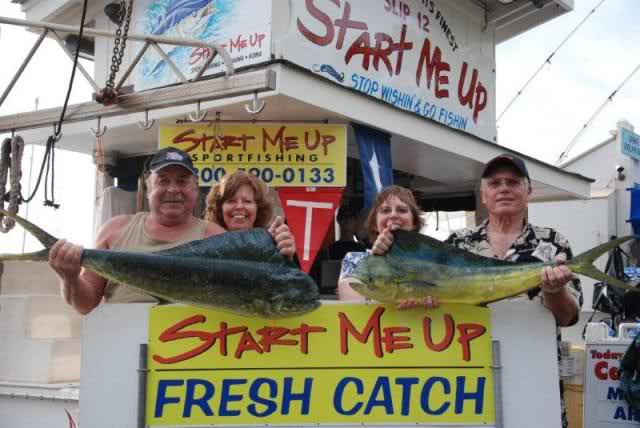
Redel Keleher and his wife Rose caught a good mahi on an afternoon trip. Harlan and Lori Wasvack also caught a nice mahi on the same trip. Each fish have been caught on lures close to sweetheart rock.
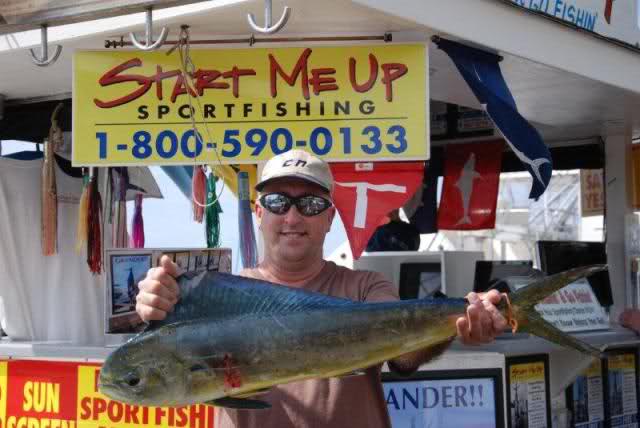
Randal Beams, a returning Start Me Up angler, caught a mahi whilst trolling off the Lanai lighthouse.

These Nebraska cornhuskers were featured in our last post with three mahis and two shibis. They decided to go out once more, this time in the afternoon, and landed two mahis, a single of which was a nice bull. With that sort of achievement rate, these guys will be back to go fishing again.
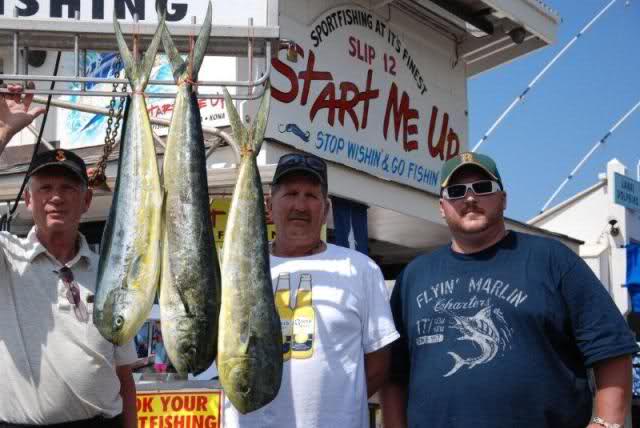
John Meeker, Vern Nelson, and Richard Crowe did Start Me Ups early trip. They went to JJ buoy behind Kahoolawe, exactly where they were in a position to bait these mahis.

Jim Erickson, Joanna Rotecka, and Bill and Cathy Carpenter got some bites just south of the Lanai lighthouse. They ended up boating a mahi and efficiently caught and released a striped marlin.

Dave Connolly, John Kingston, and Jeff and Ben Helesic caught a great bull mahi as effectively as a cow mahi while trolling at the Lanai lighthouse. The lighthouse was definitely the hot region for the day.
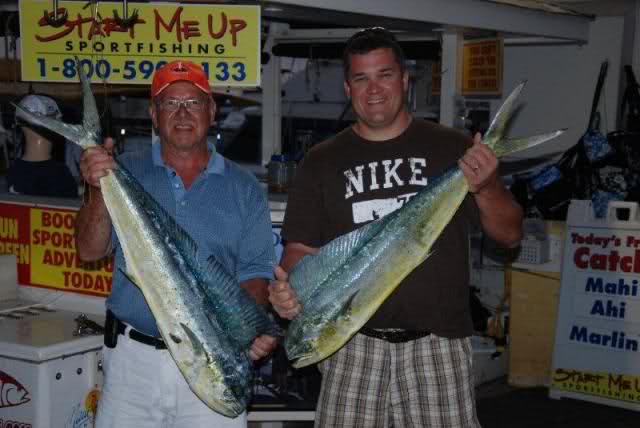
James Keller and Eldon Lindstrom got in on the late afternoon bite. They each and every caught a mahi although trolling in the vicinity of Kamaiki point on Lanai. Why get up early for the sunrise bite when the sunset bite can be just as productive?

Austin Enns fished with his brother Abram and his dad James. They had some action and missed a bunch of fish, but thanks to this mahi they didnt come house empty-handed.
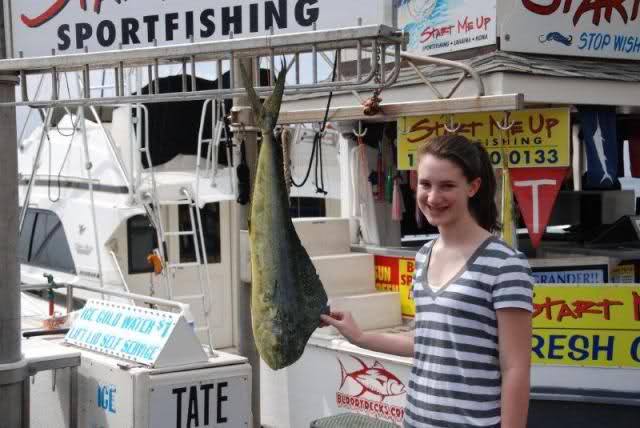
Danny Messina spent some time on the water with her loved ones and caught a mahi. She described her day as a enjoyable 1.
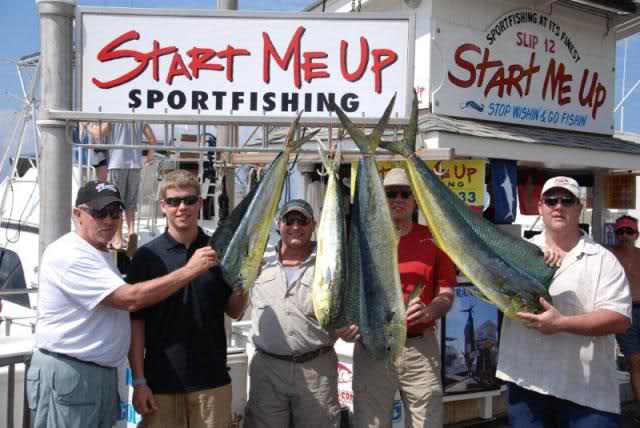
The Roaldson group discovered some fish on the backside of Kahoolawe. The fish had been active and they ended up with 4 mahis, including two nice ones.

Jay Osborne saved the morning when he boated this mahi. All of the other bites on the boat had been striped marlin that didnt stick. Thats just how it goes on the days when the hooks appear to be made of rubber. The fact that marlin have challenging, bony mouths doesnt make points any easier.

Paul Novacek celebrated his new marriage with a fishing trip. Although the trip was a short one, Paul was out on the water extended adequate to come across a mahi and a modest tuna.
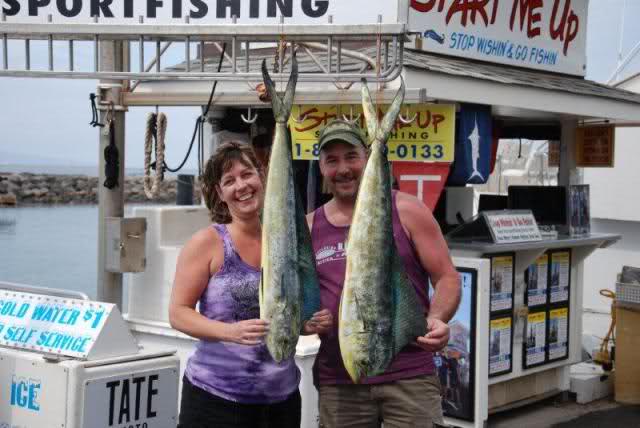
Denise and Steve Skaglund trolled the 150 fathom ledge off Lanai. They went two for two and brought these mahis back to the harbor.
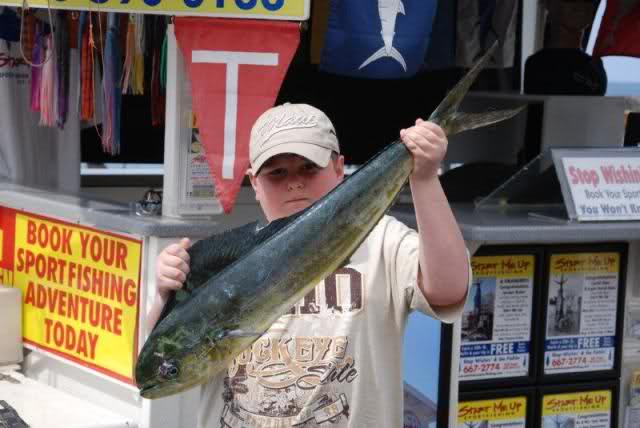
George Lollathin was one excited boy when he landed this mahi. George took residence a mahi flag as a souvenir to remind him of his thrilling experience. Way to go George!
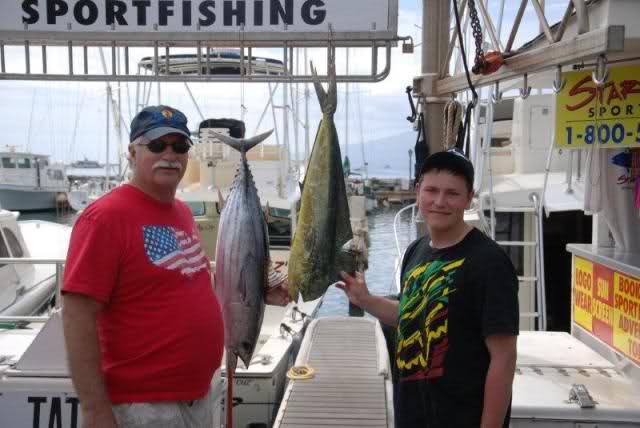
John Hartley came up with a huge aku whilst operating a porpoise pile off the Lanai lighthouse. Hayden Playter also picked up a consolation mahi proper soon after missing a striped marlin.

Dean Linn from down beneath in Victoria, Australia was pumped right after boating his mahi just inside LA buoy. Great going mate!
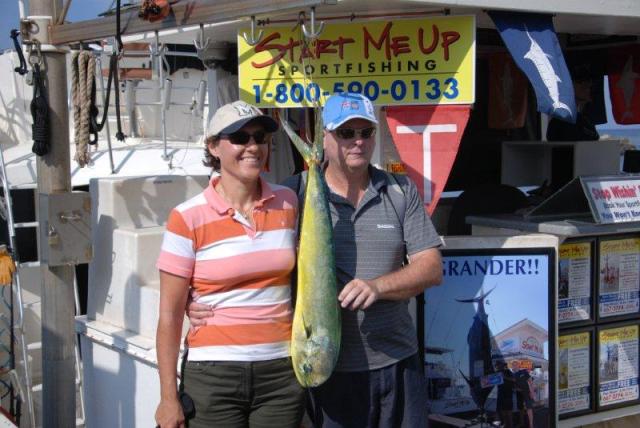
Greg Tunks and his wife, also visiting from Australia, snagged a mahi just outside LA buoy. The inside buoys seem to be holding some fish at the moment.
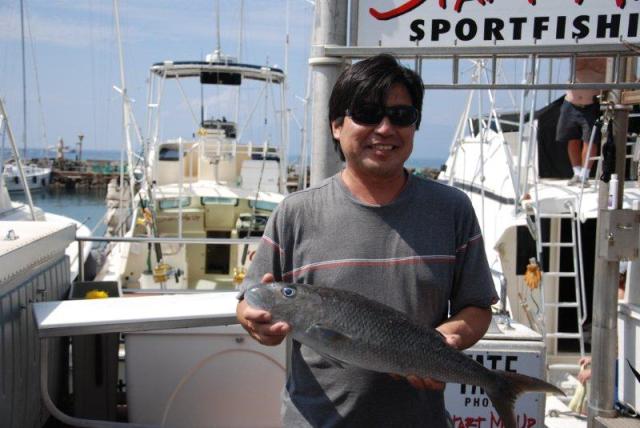
Masa Hatorri, the head sushi chef at a neighborhood restaurant, planned to make sushi for some buddies out of this uku, or grey snapper. Other bottom fishing action included nabeta and papio, which are exceptional in the frying pan.
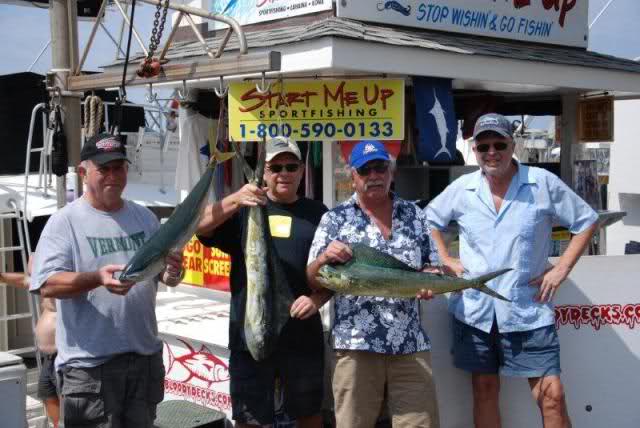
Mark Laplante, Ken Crocker, and Mark and Ross Hanson got the job accomplished with two mahis and a rainbow runner, sometimes referred to as the Hawaiian salmon. The guys said that they had a fantastic trip.

Albert Kemper was ready to pose for a picture with his mahi, but he was not the only angler that caught fish. Don Johnson caught and released an estimated 40 lb. shortbill spearfish and George Ochs caught and released a kaku, or barracuda. Releasing shortbill spearfish and kaku is often great when there is currently a mahi in the fish bag.

Arnom Reithers and Chuck and Jill Sadler had a successful four hour afternoon trip. They landed two shibis on a double bite and topped that off with a mahi.
Thanks for checking out another Start off Me Up fishing report. As can be noticed in the pictures, the fishing has been comparatively productive lately. With any luck, the fishing will continue to boost and the subsequent report will contain even more great catches. For far more information on the fishing, bear in mind to call Deli at 808-667-7879 amongst 9 a.m. and five p.m. or e-mail startmeupfish@gmail.com so that he can fill you in. I actually just got word that 2010 Lahaina Harbor captain of the year, Commence Me Up’s Captain Steve Cravens, is hooked up to a 500 plus lb. blue marlin. Hopefully he’ll hang on to it and get it to the boat. Until subsequent time, tight lines.
Aloha,
Jonny
Sport Fishing Forums – Offshore Big Game Fishing News Click Here
——-
Don’t Know if I got the Man hood to do this
Kinda brings this to thoughts
Sport Fishing Forums – Offshore Large Game Fishing News Click Here
——-
Hammerhead eats Tarpon
Sport Fishing Forums – Offshore Big Game Fishing News Click Here
——-
Spain: Industry leaders advocate improved fisheries management of shark catches
Industry leaders advocate improved fisheries management of shark catches
Tuesday, February 22, 2011, 03:50 (GMT + 9)
The Spanish Fisheries Confederation (Cepesca) reiterated its "absolute rejection" of shark finning and advocated the establishment of ratios or percentages of correspondence between the weight of fins and bodies for each of the shark species that are fished.
The organization believes that in this way, it will help to eradicate this practice, which involves cutting off shark fins and discarding the body.
While the specimens are released alive, then die off slowly.
According to the secretary general of Cepesca, Javier Garat, the profitability of the 250 Spanish longline vessels depend on full utilization of shark catches.
A total of 55 per cent of revenues from sales are obtained from the marketing of meat, with the remainder coming from the sale of fins, he said.
For Cepesca, it is necessary to amend the regulations governing the removal of shark fins on board vessels "to adjust to the reality of State fisheries, through the definition of Maximum Allowable Ratios (MAR) by type of fleet, species or species groups and product presentation, ensuring that the fins correspond to the bodies that are landed."
The Spanish longline fleet achieves an average annual catch of 45,000 tonnes of sharks, which is 7 per cent of worldwide shark catches.
Around 98 per cent of these vessels fish for blue and shortfin mako.
Garat said that chilled and freezer vessel owners categorically reject the practice of shark finning.
"Indeed, the economic viability of the longline fleet fishery is in the marketing of all the usable shark parts," he said.
He added: "Obviously, the simple approach to jettison part of this economic performance is completely absurd and has no logical justification as an economic activity on which many people rely on."
For its part, environmental organizations and representatives of the European Commission (EC) recognize that they do not have any arguments that allow them to accuse the EU fleet of finning.
"The Spanish and EU fleet does not practice finning and some ignore us when we explain that our methods have nothing to do with finning," says José Ramón Fuertes, director of the Cooperative of Shipowners of Vigo, and Concepción Ortega, of Espaderos Guardeses.
"We are the most interested in preserving resources, which is demonstrated by the fact that we were the first to stop catching species such as hammerhead sharks," he added.
He also stressed that finning is carried out by "other fleets, such as Asian ones, but not the Spanish."
"We comply with the law and what does not make sense is that the European Union imposed on us a lot of rules that harm us and in other areas do not apply, there should be rules for everyone," Fuertes told the newspaper Faro de Vigo.
Related article:
– EC moves to eradicate shark finning
By Analia Murias
editorial@fis.com
www.fis.com
Sport Fishing Forums – Offshore Big Game Fishing News Click Here
——-
EC moves to eradicate shark finning
EUROPEAN UNION
Thursday, November 18, 2010, 01:10 (GMT + 9)
The European Commission (EC) wants to abolish shark finning in the European Union (EU) and on fishing vessels from the Union anywhere in the world. EU legislation banned shark finning in 2003, but controlling adherence to the ban under the current system is difficult.
To fortify the existing legislation, the EC is requesting that the scientific community, the industry, Regional Fisheries Management Organisations (RFMOs), NGOs and any interested parties offer their opinions over a 12-week consultation period starting this week. The input received plus the latest scientific knowledge from across the globe will together help feed a proposal for a new and more effective EU law to completely ban shark finning.
The practice of shark finning is prohibited by RFMOs and is illegal almost worldwide. It adds to the excessive mortality and stock depletion of several shark species, many of which are already seriously endangered.
But shark finning persists illegally because the lucrative fins can fetch dozens of times more money per kg than the rest of the shark meat. And with limited on-board storage space, fishers have a strong incentive to discard carcasses but keep the fins.
As it has become apparent that the current system controls do not allow for 100 per cent accuracy, the fishing industry, NGOs and RFMOs all agree that the legislation should be revised. In 2009, the EC vowed to perform such a revision in its Action Plan for the Conservation and Management of Sharks.
Loopholes in the 2003 EU regulation allow fishers to fin about two of three sharks onboard without detection or retribution. The EC is asking for input on three options for amending the relevant regulation.
Several potential solutions are envisioned for the revision. The Commissions published consultation document gives the main options now being globally discussed by experts.
The consultation will close on 21 February 2011 and the new piece of legislation would come out in the first half of the year.
The Shark Alliance has already offered its support to the option to amend the EU ban on shark finning that would demand that fins remain naturally attached to the shark until the fishing boats return to port. This would result in tremendously improved enforcement of the law as well as allow for better species-specific catch data collection, which is key for the assessment and management of shark stocks.
For too long, the EU has left the door open to shark finning, said Uta Bellion, director of the Pew Environment Groups European Marine Programme and European coordinator of the Shark Alliance. This consultation could result in a substantial policy improvement, particularly if the one truly reliable option for preventing finning – a complete prohibition on the removal of shark fins at sea – is adopted.
Related article:
– Warning issued at UN fish stocks review
By Natalia Real
editorial@fis.com
www.fis.com
Sport Fishing Forums – Offshore Big Game Fishing News Click Here
——-
Huge Sailfish on Kayak
Sport Fishing Forums – Offshore Big Game Fishing News Click Here
——-





